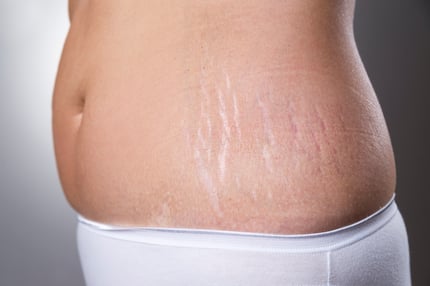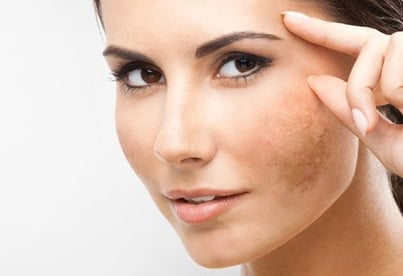Pregnancy isn’t all glowing skin and luscious hair. Often, the hormonal changes that occur during pregnancy can cause all kinds of noticeable changes – not just in your weight and mood, but also in the condition and appearance of your skin. Here are a few examples of common skin concerns during pregnancy, and how you can remedy them.
Stretch marks
 As the pregnancy progresses, you might notice some dryness and itchiness around the area where the skin is becoming stretched. As the skin is stretched thin, streaks that are red, pink, tan, yellow or purplish in colour can appear on the tummy, as well as the breasts and thighs. Stretch marks are so common that they occur in 9 out of 10 pregnancies, and usually begin to appear during the second and third trimesters.
As the pregnancy progresses, you might notice some dryness and itchiness around the area where the skin is becoming stretched. As the skin is stretched thin, streaks that are red, pink, tan, yellow or purplish in colour can appear on the tummy, as well as the breasts and thighs. Stretch marks are so common that they occur in 9 out of 10 pregnancies, and usually begin to appear during the second and third trimesters.
- Solution: While skincare products may claim to prevent or treat stretch marks, it is unlikely that they will remove them altogether. Some people may simply be genetically predisposed to develop stretch marks during pregnancy. Typically, stretch marks lighten and fade after delivery, but the best way to reduce the appearance of stretch marks is to exercise regularly, drink at least 8-10 cups of water per day, and apply lotions that contain vitamin E and exfoliating alpha-hydroxy acids. Skin hydration is key, which in turn improves elasticity in the dermis.
Related: What is Cell Turnover or Skin Cycle?
Changes in pigmentation
 A little-known fact about pregnancy is that your skin may become extra sensitive and more prone to sun damage. As a result, pigment-producing cells called melanocytes are more easily triggered, making the skin susceptible to pigmentation such as freckles, age spots, linea nigra (the darkened line down your belly), and melasma. Caused by hormonal changes, melasma is often referred to as the “mask of pregnancy” and can appear as brown symmetrical patches on the face, arms or back – made worse by sun exposure.
A little-known fact about pregnancy is that your skin may become extra sensitive and more prone to sun damage. As a result, pigment-producing cells called melanocytes are more easily triggered, making the skin susceptible to pigmentation such as freckles, age spots, linea nigra (the darkened line down your belly), and melasma. Caused by hormonal changes, melasma is often referred to as the “mask of pregnancy” and can appear as brown symmetrical patches on the face, arms or back – made worse by sun exposure.
- Solution: Now more than ever is the time to be extra vigilant about finding the right sunscreen for your skin type and using it properly. For mothers-to-be, we recommend using physical sunscreens that reflect UV rays using titanium dioxide or zinc dioxide (as opposed to skin-absorbent chemical sunscreens). Use sunscreen with at least SPF 30 as the last step of your skincare routine every day, and re-apply every 2-3 hours for maximum protection while you’re outside. For effective at-home treatment of pigmentation, we recommend the gentle and non-invasive green wavelength of LED light phototherapy. The green light wavelength has a calming and anti-inflammatory effect on the skin, breaking up melanin clusters and lightening hyperpigmentation.
Oily skin & acne breakouts
That “pregnancy glow” you’re experiencing could have a lot to do with the body’s production of hormones called androgen, which stimulates sebaceous glands to produce more oil. Excessive sebum production can naturally lead to acne flare-ups, as pores become more easily clogged. Your skin during puberty is a good indication of how your skin might react to pregnancy hormones, which is similarly affected by the female hormone cycle. If you had acne as a teenager, you are more likely to experience breakouts during pregnancy, especially during your third trimester when androgen production is in overdrive.

- Solution: The best preventative measure against acne during pregnancy is to wash your face with a gentle cleanser 2-3 times per day, and after every sweat session to keep pores clean. Avoid using Vitamin A-derived retinoids and retinol, ingredients celebrated for their effective prevention of acne and fine lines by stimulating cell turnover, which have been proven to affect embryo development in the first trimester of pregnancy. Some over-the-counter ingredients that can be used during pregnancy include topical benzoyl peroxide, azelaic acid, topical salicylic acid, and glycolic acid.
Related: How does Pore Size Change over Time? Can We Shrink Pores?
Veins, veins, and more veins
 While totally harmless and usually gone within three months after delivery, the unsightly appearance of twisting veins can be yet another temporary side effect of pregnancy. Varicose veins are of the bulky, bulgy variety that occur on the legs as a result of the uterus applying pressure to the large vein that carries blood from the heart to your lower body. Spider veins are thin and bluish veins that appear as a series of short, scraggly lines, and can occur alone or alongside varicose veins. The increased blood flow during pregnancy causes significant pressure on even small blood vessels, making them swell.
While totally harmless and usually gone within three months after delivery, the unsightly appearance of twisting veins can be yet another temporary side effect of pregnancy. Varicose veins are of the bulky, bulgy variety that occur on the legs as a result of the uterus applying pressure to the large vein that carries blood from the heart to your lower body. Spider veins are thin and bluish veins that appear as a series of short, scraggly lines, and can occur alone or alongside varicose veins. The increased blood flow during pregnancy causes significant pressure on even small blood vessels, making them swell.
- Solution: First off, avoid placing excess pressure on your legs. Blood vessels are already working against gravity to circulate blood flow back up the body, with extra restrictions from an ever-expanding uterus. Avoid crossing your legs and elevate your legs when resting to ease circulation. Keep blood flowing with regular exercise, and don’t wear tight-fitting clothes or shoes. Maintain a healthy diet that is rich in foods with Vitamin C, which is used by the body to produce collagen and elastin, important proteins that repair and maintain skin and blood vessels.
While pregnancy hormones can account for a series of annoying and downright stressful changes in your skin, remember that these changes are normal and often only temporary. Soon enough, all of this will seem like a mere speck in the otherwise wonderful journey of pregnancy. Take care of your body, and just as importantly, your mental health, and get ready to welcome the most exciting new chapter of your life – one rife with changes.
.png?width=180&height=80&name=imgpsh_fullsize_anim%20(1).png)

